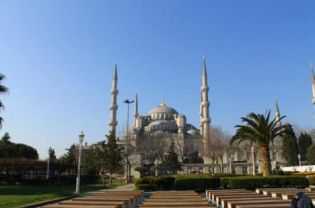“There are 4,000 mosques in [Istanbul], some are just stunning, and it really makes me think about becoming a Muslim.”
 This quote from Liam Neeson, an Irish actor who made a movie in Istanbul, was in some tabloids earlier this year, leaving some to assume that he had converted to Islam.
This quote from Liam Neeson, an Irish actor who made a movie in Istanbul, was in some tabloids earlier this year, leaving some to assume that he had converted to Islam.
Whether or not Neeson will actually follow up on his words, he was definitely right about one thing: the mosques in Istanbul are breathtaking.
Metropolitan Istanbul, Turkey’s largest city, is home to more than 3,000 mosques, with 600 of them legacies of the Ottoman Empire. Most of these Ottoman mosques are strikingly beautiful. When stopping to pray in some of them, you cannot help but notice the beauty and enormity.
One of the most famous Ottoman Empire mosques is the Sultanahmet Mosque, or Blue Mosque, situated in the heart of Istanbul’s old city. It is one of the most remarkable and striking mosques in the Islamic world. The construction alone took seven years, and Sultan Ahmet I commissioned it in 1601 when he was only 19 years old.
The architect misinterpreted the instructions to build altin (gold) minarets with alti (six) minarets. In the end, Sultanahmet Mosque stands grandly with six slender minarets. It has a huge dome that stands 43 meters high and a series of smaller domes that cascade down to each level. The mosque was built to show the glory of Islam and to rival Ayasofya Mosque, which is located a short walk away.
The 53-by-51-square-meter interior of Sultanahmet Mosque was designed to present the greatness of God, so anybody praying inside would sense its vastness.
The ceiling is lined with 20,000 tiles of the 16th century Iznik design, with 50 different designs of tulip, Turkey’s official flower. It is from these turquoise tiles that the mosque got the name Blue Mosque.
Because Islam prohibits figurative art, the interior feature Koranic verses, flowers, trees and geometric shapes. A huge eye-catching chandelier hangs beneath the central dome. The area below is restricted for the countless visitors that come to the mosque every day. The interior is lit by 260 windows that bathe the space in light.
In Ottoman times, the mosque was an integral part of public life. The mosque complex included a Koran school, caravanserai (lodging for travelers), a hospital, a primary school, a market, several shops and a kitchen that provided soup for the poor. In the 19th century, however, those buildings were all torn down.
While entrance to the Blue Mosque is free, to visit Ayasofya, or Hagia Sophia, a former Orthodox basilica and mosque that is now a museum, you will likely have to brave a long line to buy a ticket. Taking an official tour might be a good idea because it allows you to skip the line to get into one of Istanbul’s can’t-miss destinations.
The museum is striking with its massive central dome and four minarets. It is a jewel of Byzantine architecture, featuring impressive works of art and tracing the historical journey of Ayasofya and the changing powers in Istanbul.
Inside, the building is 70 meters by 75 meters of layered white marble. The central dome is 31 meters in diameter and soars 55 meters high. It has massive vaults supported by huge columns of green and white marble at both levels. Mosaics — figurative decorations and circular frame disks inscribing the names of Allah and the Prophet Muhammad — decorate the vault. The second level is a gallery with an empty library and mosaics on the wall.
Ayasofya, Turkish for “holy wisdom,” was initially an Orthodox patriarchal basilica built by Constantine the Great during the Byzantine Empire in the fourth century. The original building was at one point destroyed by fire.
Theodosius II rebuilt the church and that too was destroyed. Emperor Justinian I rebuilt the church for the third time in the 6th century with an entirely different basilica. The construction used Hellenistic columns from the Artemis Temple in Ephesus and black stone from the Bosporus region in Turkey, large stones from Egypt, green marble from Thessaly, Greece, and yellow stone from Syria. More than 10,000 people were involved in the construction.
Justinian’s basilica was the first masterpiece of Byzantine architecture and later influenced Greek and Roman churches, as well as Muslim mosques.
For more than 900 years, the church was the seat of the Orthodox Patriarch of Constantinople and became the largest cathedral in the world. Ayasofya remained a functioning church until 1453 when Sultan Mehmet II of the Ottoman Empire conquered Byzantine.
Fascinated by the beauty of Ayasofya, the sultan immediately converted it into his imperial mosque. Initially, no major changes were made, though the church mosaics that depicted figurative images were covered in plaster. The sultan added a mihrab (prayer niche), mimbar (pulpit) and a wooden minaret.
Sultan Mahmud I later restored the mosque and added an ablution fountain, a Koran school, a soup kitchen and a library. Sultan Abdulmecid also made extensive restorations between 1847 and 1849, reworking the decorations and adding disks with the names of Allah, Prophet Muhammad, the four caliphs and the grandsons of the prophet.
For almost 500 years, Ayasofya was Istanbul’s principal mosque and a model for other Ottoman mosques in Istanbul, such as Sultanahmet, Suleiman, Sehzade and Rustam Pasha.
via Finding Religion Through Istanbul’s Mosques | The Jakarta Globe.

Leave a Reply